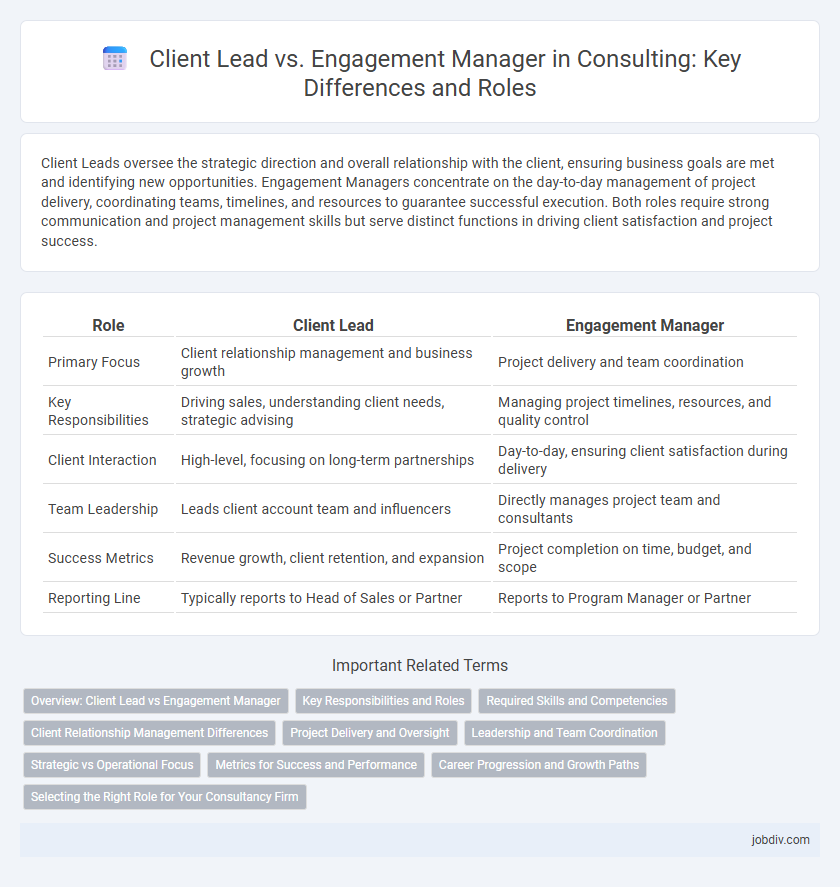Client Leads oversee the strategic direction and overall relationship with the client, ensuring business goals are met and identifying new opportunities. Engagement Managers concentrate on the day-to-day management of project delivery, coordinating teams, timelines, and resources to guarantee successful execution. Both roles require strong communication and project management skills but serve distinct functions in driving client satisfaction and project success.
Table of Comparison
| Role | Client Lead | Engagement Manager |
|---|---|---|
| Primary Focus | Client relationship management and business growth | Project delivery and team coordination |
| Key Responsibilities | Driving sales, understanding client needs, strategic advising | Managing project timelines, resources, and quality control |
| Client Interaction | High-level, focusing on long-term partnerships | Day-to-day, ensuring client satisfaction during delivery |
| Team Leadership | Leads client account team and influencers | Directly manages project team and consultants |
| Success Metrics | Revenue growth, client retention, and expansion | Project completion on time, budget, and scope |
| Reporting Line | Typically reports to Head of Sales or Partner | Reports to Program Manager or Partner |
Overview: Client Lead vs Engagement Manager
Client Leads focus on strategic client relationships, driving business development and ensuring alignment with long-term objectives. Engagement Managers oversee project execution, managing teams and resources to deliver specific client engagements successfully. Both roles require strong leadership, but the Client Lead emphasizes external client partnership while the Engagement Manager concentrates on internal project delivery.
Key Responsibilities and Roles
Client Leads drive business development by managing client relationships, identifying growth opportunities, and ensuring client satisfaction throughout the project lifecycle. Engagement Managers oversee project execution, coordinating between clients and internal teams to deliver solutions on time, within scope, and budget. Both roles require strategic communication skills, but Client Leads emphasize sales and client retention, while Engagement Managers focus on operational management and team leadership.
Required Skills and Competencies
Client Leads excel in relationship management, strategic thinking, and business development skills, with a strong ability to align client goals with firm capabilities. Engagement Managers require proficiency in project management, team leadership, and communication skills to ensure effective delivery and resource coordination. Both roles demand analytical problem-solving and stakeholder management, but Client Leads focus more on client acquisition while Engagement Managers prioritize project execution.
Client Relationship Management Differences
Client Leads primarily drive strategic client relationship management by identifying growth opportunities and aligning consultancy services with client business goals. Engagement Managers focus on operational client relationship activities, ensuring project delivery meets client expectations and managing day-to-day communication between consulting teams and stakeholders. The key difference lies in Client Leads steering high-level client engagement and long-term partnership development, while Engagement Managers handle tactical client interactions and project execution support.
Project Delivery and Oversight
Client Leads drive strategic client relationships and ensure alignment with business objectives, while Engagement Managers focus on the operational execution and day-to-day management of project delivery. Engagement Managers oversee resource allocation, timeline adherence, and quality control to meet project milestones effectively. Both roles collaborate to balance client expectations with project oversight, ensuring successful consultancy outcomes.
Leadership and Team Coordination
Client Leads drive strategic vision and maintain high-level client relationships, ensuring alignment with business goals while inspiring cross-functional teams. Engagement Managers focus on operational execution, coordinating daily activities, managing project timelines, and facilitating communication among team members to meet deliverables. Both roles require strong leadership, but Client Leads prioritize client strategy and growth, whereas Engagement Managers emphasize team coordination and project delivery.
Strategic vs Operational Focus
Client Leads prioritize strategic relationship building and long-term business growth by aligning client goals with the consultancy's vision. Engagement Managers concentrate on operational execution, managing project deliverables, timelines, and team coordination to ensure successful outcomes. The Client Lead drives high-level decision-making and client satisfaction, while the Engagement Manager ensures day-to-day project efficiency and quality control.
Metrics for Success and Performance
Client Leads drive business growth by securing new projects and nurturing client relationships, with success measured through client retention rates and revenue expansion. Engagement Managers focus on delivering project outcomes on time and within budget, utilizing metrics like project completion rates, client satisfaction scores, and resource utilization. Both roles rely on KPI tracking and stakeholder feedback to optimize performance and ensure alignment with strategic objectives.
Career Progression and Growth Paths
Client Leads typically focus on business development, client relationships, and strategic oversight, positioning themselves for roles like Director or Partner with expanded revenue responsibilities. Engagement Managers concentrate on project delivery, team leadership, and operational execution, building expertise that advances toward Program Manager or Principal Consultant positions. Transitioning from Engagement Manager to Client Lead often involves developing stronger sales acumen and client management skills to drive business growth and influence.
Selecting the Right Role for Your Consultancy Firm
Client Leads prioritize building and maintaining strong client relationships to secure ongoing business opportunities, making them essential for revenue growth and client retention. Engagement Managers focus on overseeing project delivery, coordinating teams, and ensuring that client expectations are met on time and within budget. Selecting the right role depends on your consultancy firm's needs for business development versus project execution efficiency.
Client Lead vs Engagement Manager Infographic

 jobdiv.com
jobdiv.com